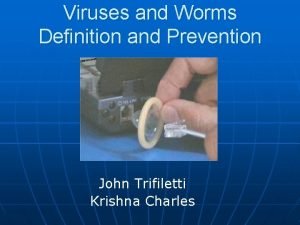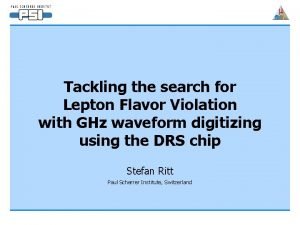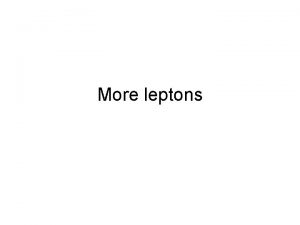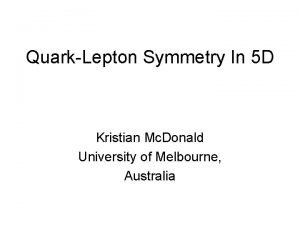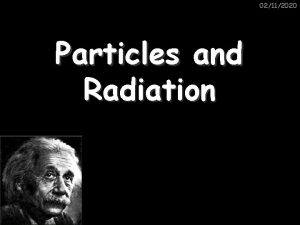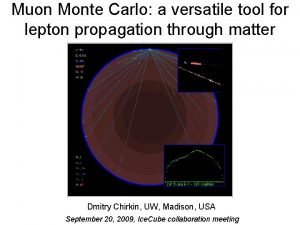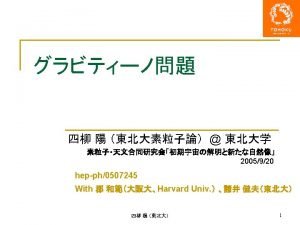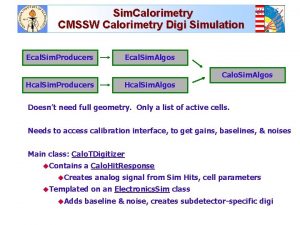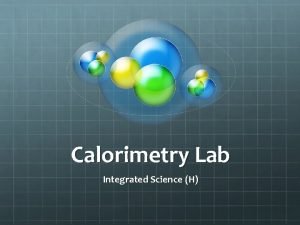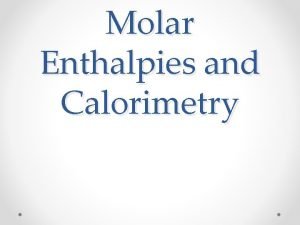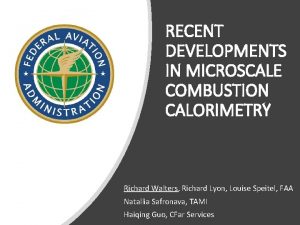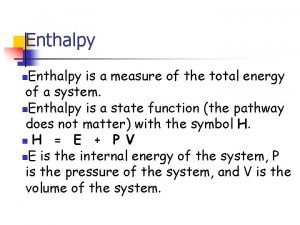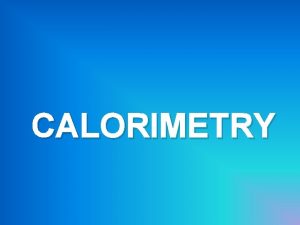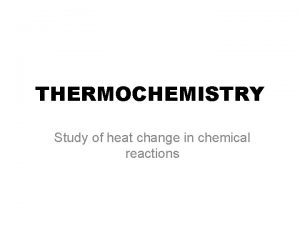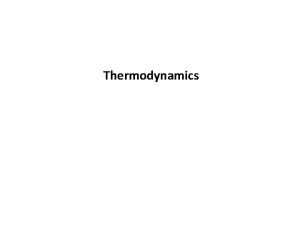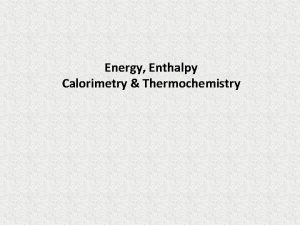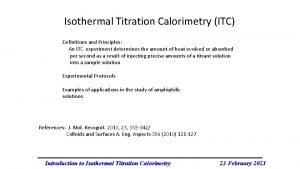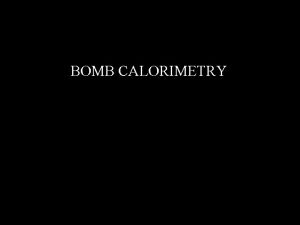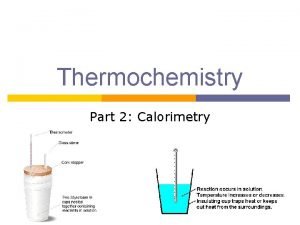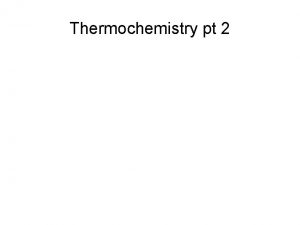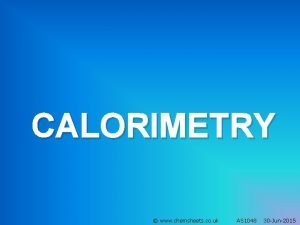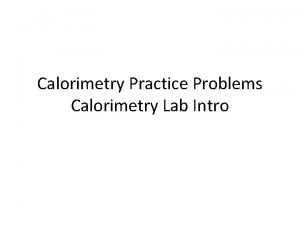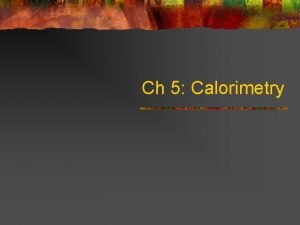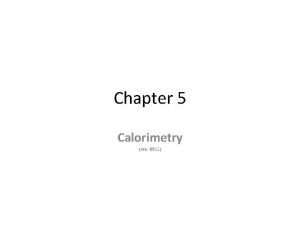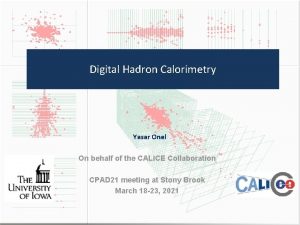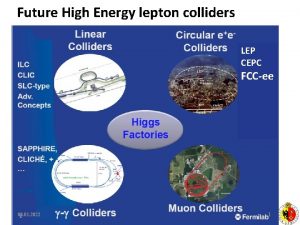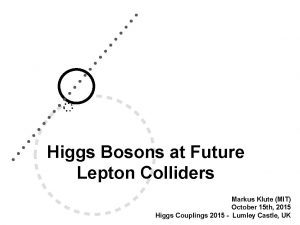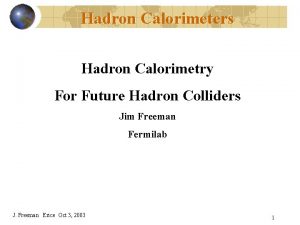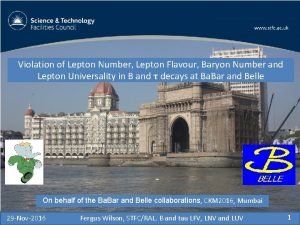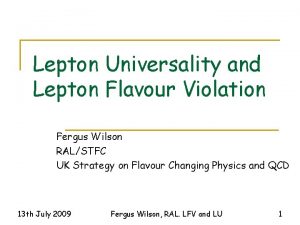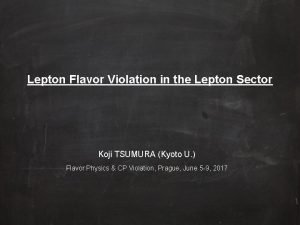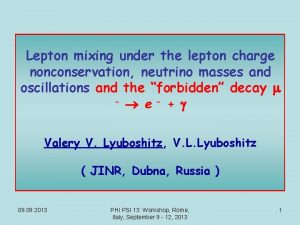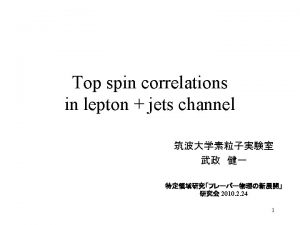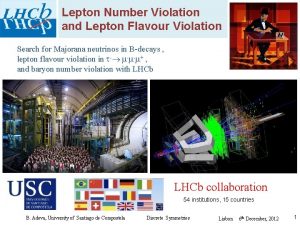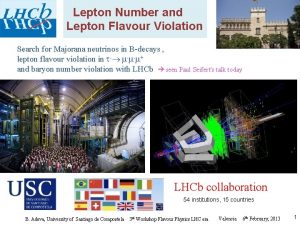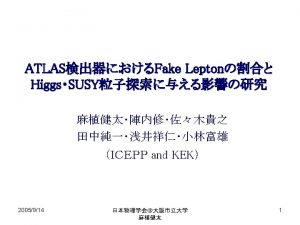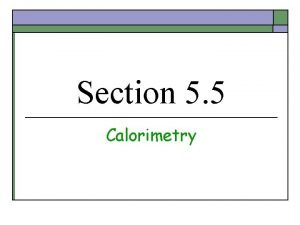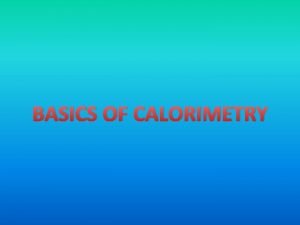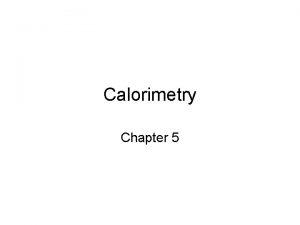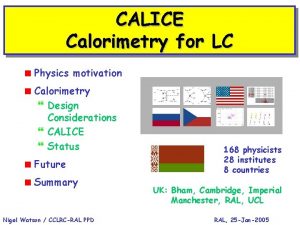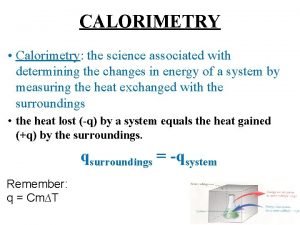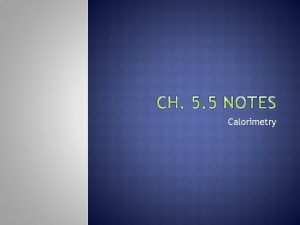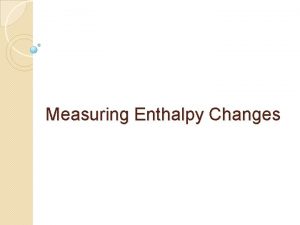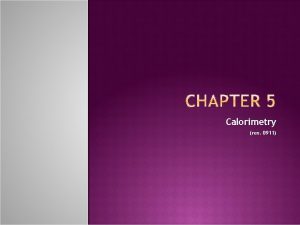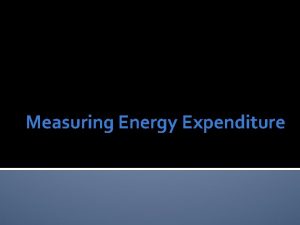Calorimetry RD for Future Lepton Colliders Y Onel





















































- Slides: 53

Calorimetry R&D for Future Lepton Colliders Y. Onel University of Iowa March 8, 2012 1

Calorimetry for Future Lepton Colliders • Should be able to reflect the advancements in both concept and technology • Should be able to comply with future new physics requirements (with best estimates) • Should have strong evidence that it will work 2

The Digital Calorimeter Project RPC – based imaging calorimeter DHCAL = First large scale calorimeter prototype with Embedded front end electronics Digital (= 1 – bit) readout Pad readout of RPCs (RPCs usually read out with strips) DHCAL = World record channel count for calorimetry Argonne National Laboratory Boston University Fermi National Accelerator Laboratory IHEP Beijing Illinois Institute of Technology University of Iowa Mc. Gill University Northwestern University of Texas at Arlington DCHAL Collaboration Heads Engineers/Technicians 22 Students/Postdocs 9 Physicists 10 Total 41 …and integral part of 3

1 m 3 – Digital Hadron Calorimeter Physics Prototype Description Readout of 1 x 1 cm 2 pads with one threshold (1 bit) → Digital Calorimeter Layers inserted into the existing CALICE Analog (scintillator) HCAL and TCMT structures 38 layers in DHCAL and 14 in tail catcher (TCMT), each ~ 1 x 1 m 2 Each layer with 3 RPCs, each 32 x 96 cm 2 ~480, 000 readout channels Purpose Validate DHCAL concept Gain experience running large RPC systems Measure hadronic showers in great detail Validate hadronic shower models (Geant 4) Status Started construction in 2008 Completed in 2010 Several test beam campaigns at Fermilab 4

The DHCAL in the Test Beam Run III Run IV Run V Date DHCAL layers RPC_TCMT layers SC_TCM T layers Total RPC layers Total layers Readout channels 10/14/2010 – 11/3/2010 38 0 16 38 54 350, 208+320 1/7/2011 – 1/10/2011 38 0 8 38 46 350, 208+160 1/11/2011 – 1/20/2011 38 4 8 42 50 387, 072+160 1/21/2011 – 2/4/2011 38 9 6 47 53 433, 152+120 2/5/2011 – 2/7/2011 38 13 0 51 51 470, 016+0 4/6/2011 – 5/11/2011 38 14 0 52 52 479, 232+0 5/26/2011 – 6/28/2011 38 14 0 52 52 479, 232+0 11/2/2011 – 12/6/2011 50 0 0 50 50 460800 ~ 480 K readout channels ~ 35 M events 5

General DHCAL Analysis Strategy Noise measurement Determine noise rate (correlated and not correlated) Identify (and possibly mask) noisy channels Provide random trigger events for overlay with MC events (if necessary) Measurements with muons Geometrically align layers in x and y Determine efficiency and multiplicity in ‘clean’ areas Simulate response with GEANT 4 + RPCSIM (requires tuning 3 6 parameters) Determine efficiency and multiplicity over the whole 1 x 1 m 2 Compare to simulation of tuned MC Perform additional measurements, such as scan over pads, etc… Measurement with positrons Determine response Compare to MC and tune 4 th (dcut) parameter of RPCSIM Perform additional studies, e. g. software compensation… Measurement with pions Determine response Compare to MC (no more tuning) with different hadronic shower models Perform additional studies, e. g. software compensation, leakage correction… 6

Beam and Trigger for Muon events Trigger +32 Ge. V/c secondary beam + 3 m Fe DAQ rate typically 500 1000/spill DHCAL TCMT 1 x 1 m 2 Scintillator Paddle A 1 x 1 m 2 Scintillator Paddle B Run # of muon events October 2010 1. 4 Million January 2011 1. 6 Million April 2011 2. 5 Million June 2011 2. 2 Million November 2011 1 Million TOTAL ~ 9 Million 7

Alignment For each readout board i plot residual in x/y Rix = xi cluster xitrack Dimensions in [cm] Riy = yicluster – yitrack Variations < 3 mm Variations < 0. 5 mm 8

Efficiencies, multiplicities Tail catcher is cooler → lower efficiency, multiplicity TCMT DHCAL Calibration factors = mean of multiplicity distribution/(average over detector) = ε·μ/ ε 0·μ 9 0

Pion-Positron Preliminary Analysis First look at data To provide possible feedback to data taking and setup Speed is important! Develop analysis tools Final analysis will require large effort This is the beginning… Trigger Ultimate goals Validate the DHCAL concept Measure hadronic showers in great detail Cerenkov Topological particle identification – details can be found in Calice Analysis Note CAN 032 DHCAL TCMT 10

Results - October 2010 Data CALICE Preliminary 11

DHCAL Response to Hadrons response not calibrated 32 Ge. V/c not included in the fit. Standard pion selection + No hits in last two layers (longitudinal containment) B. Bilki et. al. JINST 4 P 10008, 2009. MC predictions for a large-size DHCAL based on the Vertical Slice Test. 12

DHCAL Response to Positrons response not calibrated N=a+b. Em Green line prediction Uncorrected for non-linearity Correction for non-linearity Needed to establish resolution Correction on an event-by-event basis B. Bilki et. al. JINST 4 P 04006, 2009. Data (points) and MC (red line) for the Vertical Slice Test and the MC predictions for a largesize DHCAL (green, dashed line). 13

Digital Calorimetry Hadron showers were observed with unprecedented spatial resolution. DHCAL specific algorithms are being generated. Calorimetric properties are within expectations with a first look analysis. The DHCAL concept is being validated. 14

Total Absorption Dual Readout Calorimetry IOWA-FNAL-FAIRFIELD-MISSISSIPPI-TRIESTE Focus on establishing a proof of concept for totally active hadron calorimetry. Evaluate the performance of: Different crystal and glass samples Different readout techniques to optimize the simultaneous collection of Čerenkov and scintillation light components for application of the Dual Readout technique to Total Absorption Calorimetry. Obtain a baseline for the detailed simulations of Čerenkov and scintillation light production in different crystals. 15

Beam Test at FTBF One 5 x 5 cm 3 BGO crystal. Provides information about scintillation and Čerenkov light yield as a function of time, wavelength, position and photodetector type. All sides equipped with UV or visible filters Two sides viewed with PMTs (one through UV, one through visible filter) Remaining four sides equipped with 9 Hamamatsu Si. PMs each, located at different positions 1 mm Hamamatsu MPPCs with 25, 50 and 100 micron pixels 16

Beam Test at FTBF Six BGO and six Pb. F 2 crystals. All 5 cm length. 2 x 2 cm 2, 3 x 3 cm 2, 4 x 4 cm 2. 3 mm Hamamatsu MPPCs located at the center of the downstream face. Different wrapping (black paper/Tyvek) and different surface finishes to provide information about light collection for Čerenkov (Pb. F 2) and scintillation (BGO) as a function of crystal geometry and surface conditions. 17

Beam Test at FTBF 120 Ge. V/c primary proton beam Fermilab TB 4 readout boards (provide 64 channels of waveform digitizers) 18

Single BGO Crystal Si. PM (UV) BGO Emission Spectrum Si. PM (vis) PMT (UV) Si. PM (vis) PMT (vis) vis → Scintillation Beam Si. PM (UV) UV → Čerenkov 19

Single BGO Crystal – Visible Filter Sides Single event waveforms TOP 200 avalanches FRONT 330 avalanches 20

Single BGO Crystal – UV Filter Sides Single event waveforms BACK BOTTOM 6 avalanches 3 avalanches 21

Total Absorption Dual Readout Calorimetry Preliminary analyses indicate that: The Čerenkov and scintillation signals are observed with the Si. PMs directly coupled to the crystals. Filters provide measurable separation of the two signals. A lot of data to: Study the spatial and timing structure of the two kinds of light production, Study the effects of type, shape, surface finish and optical coupling of the crystals on these two mechanisms, Perform detailed simulations of light production and collection 22 both for Čerenkov and scintillation components.

Calorimetry Based On Secondary Emission Iowa-Fairfield-Mississippi In a Secondary Emission detector module, Secondary Emission electrons (SEe) are generated from an SE cathode when charged hadron or electromagnetic particles or particularly shower particles penetrate the sampling module placed between absorber materials. 23

Why Secondary Emission Ionization Calorimeters? • Secondary Emission: Rad-Hard + Fast – a) Metal-Oxide SE PMT Dynodes survive > 100 Giga. Rad – b) SE Beam Monitors survive 1020 mip particles/cm 2 • SEe signal: SE surfaces inside em/had Showers: – SE yield Scales with particle momentum ~d. E/dx – e-: 3 < <100, per 0. 05 <e-<100 Ke. V (material depnt) – ~1. 05 -1. 1 or 0. 05 -0. 1 SEe- per MIP Ex: ~6 -24 MIP equiv per Ge. V sampling calorimeters - a lower limit on hadron shower SE signals –> ~60 -240 SEe- per 100 Ge. V pion shower w/ MIPs alone BUT SEe- Must be Amplified! Exactly like p. e. ! 24

GEANT 4: Cu Block, 1 cm “plates”, 100 Ge. V e incident. Shower e+/- that cross the 1 cm “gaps” are binned in both energy and depth in Cu Shower +/- electron Energies

Secondary Emission Module Design • The modules envisioned are compact, high gain, high speed, exceptionally radiation damage resistant, rugged, and cost effective, and can be fabricated in arbitrary tileable shapes. • The SE sensor module anodes can be segmented transversely to sizes appropriate to reconstruct electromagnetic cores with high precision. • The GEANT 4 estimated in a 1(5) cm sampling Cu calorimeter response performance is between 35 50 (7 10) Secondary Emission electrons per Ge. V, with a gain per SEe >105 per SEe, and an e/pi<1. 2. The calorimeter pulse width is estimated to be <15 ns. • A recent test using a mesh dynode PMT has confirmed MC results.

SEe Dynodes: Etched Metal Sheets Hamamatsu Dynodes 15 cm now -> ~50 cm Already diced from large sheets

BEAM TEST of SEe Sensor Mesh PMT and Base Facing Downstream Photocathode Reverse Bias 19 Stage Mesh 3 cm Pb 100 Ge. V e- We Expect ~500 Shower electrons to Cross Mesh -> ~25 -40 SEe assuming all Shower e = mips

BEAM TEST: 100 Ge. V electrons 3 cm Pb ~ 5 Lrad Radiator ~ Shower Max Preceding the mesh PMT w/ photocathode turned off PRELIMINARY! Fluctuations High! - PMT Dia ~ Shower Dia - Beam not centered Use Wire Ch to center NOTE µ Mip: Detection Effy ~10% Response ~1 -2 “SEe” Peak corresponds to 41 SE electrons (mesh stack gain ~105) Implies ~100 SE. e. /Ge. V, 1 Lrad sampling, possible! (exactly like 100 p. e. /Ge. V in scintillator calorimeter)

Scintillator/Crystal/Fiber Calorimetry • R&D triggered by the SLHC upgrade • Unexpectedly high improvements in design and readout • New areas of applications 30

Cherenkov Light Collection in Quartz • • Good : Quartz is radiation hard. Bad : We have to collect Cerenkov photons. Very little light !! At fixed angle. Strategy: Go deep in UV to collect Cerenkov photons. We did R&D studies on – WLS fiber geometry • Cerenkov light collection, uniformity, and efficiency – Wrapping material reflectivity tests, Aluminum, Tyvek, HEM, Mylar. 31

WLS Fibers in Quartz We showed that Cherenkov light collection inside the quartz is feasible with UV absorbing WLS fibers. F. Duru et al. “CMS Hadronic End. Cap Calorimeter Upgrade Studies for SLHC Cerenkov Light Collection from Quartz Plates” , IEEE Transactions on Nuclear Science, Vol 55, Issue 2, 734 -740, 2008. 32

QPCAL with WLS Fibers We built and tested “WLS Fiber Embedded Quartz Plate Calorimeter Prototype” U. Akgun et al. , "Quartz Plate Calorimeter as SLHC Upgrade to CMS Hadronic Endcap Calorimeters", XIII International Conference on Calorimetry in High Energy Physics, CALOR 2008, Pavio, Italy, May 2008, J. Phys. Conf. Ser. 160: 012015, 2009 33

Covering Quartz Plates with p. Tp and Zn. O We evaporated PTP and RF sputtered Zn. O over quartz plates 34

QPCAL with p. Tp We built and tested “PTP Deposited Quartz Plate Calorimeter” U. Akgun et al. "CMS Hadronic Calorimeter Upgrade Studies P Terphenyl Deposited Quartz Plate Calorimeter Prototype ", APS 2009, Denver, CO, USA, May 2009 B. Bilki et al. “CMS Hadron Endcap Calorimeter Upgrade Studies For Super LHC”, CALOR 2010, Beijing, China, May 2010 35

QPCAL with p. Tp – EM Mode We can use combination as radiation hard CMS Endcap Calorimeter (EE + HE). U. Akgun et al. “CMS Hadronic Endcap Calorimeter Upgrade Studies for SLHC P Terphenyl Deposited Quartz Plate Calorimeter Prototype'‘ IEEE Transactions on Nuclear Science, Volume 57, Issue 2, 754 -759, 2010 36

New Readout Options We tested; *) Hamamatsu S 8141 APDs (CMS ECAL APDs). The circuits have been build at Iowa. These APDs are known to be radiation hard; NIM A 504, 44 -47 (2003) *) Hamamatsu APDs: S 5343, and S 8664 10 K *) PIN diodes; Hamamatsu S 5973 and S 5973 02 *) Si PMTs 37

Alternative Readout We constructed and tested alternative readout options from p. Tp deposited quartz plates: APD, Si. PM, PIN diode. They are not very effective and most importantly, the APD and Si. PMs are not radiation hard enough for us. 38

New Readout Options We have tested ECAL APDs as a readout option. 2 APD connected to plain quartz Plate yields almost 4 times less light than fiber+PMT combination. 39

Microchannel PMT Ø Fast response time, high gain, small size, robust construction, power efficiency, wide bandwidth, radiation hardness, and low cost. Ø 8 stage device is assembled from micro machined dynodes which exhibits a gain of up to 2 4 per stage on single stage. Ø The total thickness is less than 5 mm. 8 x 4 pixel micro dynode array is shown 40

Radiation Hard WLS Fiber We Develop Radiation Hard Wavelength Shifing Fibers: Quartz fibers with PTP/Zn. O covered core. We built a radiation hard WLS fiber prototype. Deposited p. Tp on the stripped region, on both face. Then the whole ribbon will be sandwiched between quartz plates. 41

Radiation Hard WLS Fiber We prepared a “homemade” rad hard WLS fiber. We stripped the plastic cladding from QP fibers for “middle 20 cm” portion of 60 cm fibers. This unit was tested with 80 Ge. V electron shower. The red line show the pedestal. With a very simple prototype we collected substantial signal. We try to optimize the model using Geant 4 simulations. 42

Compton Polarimetry for Future Lepton Colliders * Upstream polarimeter to measure the undisturbed beam before collisions. * SM asymmetries * Compton polarimetry Necessary to obtain a sub 1% (~0. 25%) polarization accuracy. Accurately measure depolarization effects. 43

Compton Polarimetry Baseline ILC RDR 44

Quartz Fiber Calorimeter Beam Iron rods of 6 mm diameter, 45 cm length (~25 X 0). Quartz fibers in between the rods (0. 3 mm core diameter). 20 cm x 20 cm lateral size. Single readout of the bundled fibers. Tested with 45, 80 and 120 Ge. V/c electron beams. Needs to measure scattered photons – EM calorimetry 45

Quartz Fiber Calorimeter 46

Čerenkov Detector A Novel Approach! Si. PMs directly coupled to the downstream surface of the crystal! Needs to have very good position resolution 20 cm x 1 cm Pb. F 2 n=1. 78 → Čerenkov angle ~ 57 o 2 cm Si. PM seperation Si. PM response ↔ number of photons 50 Ge. V e beam ~ Compton edge @ 500 Ge. V 47

Summary • Many new approaches with solid understanding and proof of concept. • R&D in most of these projects will soon be completed and ready for real detector implementations. • Many novel detector concepts are being validated and new areas of implementation are searched for. 48

Back up 49

Noise Measurement 7 event categories in noise (self triggered) runs (in/out of spill): 1. 2. 3. 4. 5. 6. 7. Low multiplicity random noise High multiplicity random noise Cosmic rays & beam muons Ground connector related noise Board noise Ground connector & board noise Beam events • Number of ‘dead’ asics is very small • RPC’s are in good shape after several beam tests – Average noise level is stable – Absolute noise level fluctuates with temperature • Noise contribution to triggered beam data is extremely small (~0. 1 hit/event for entire DHCAL+TCMT – 480 K channels) – This noise level corresponds to ~6 Me. V/event – RPCs contribute negligible noise hits to beam data – Correlated noise level needs more study • Noise ‘hot spots’ are due to unclean surface – Not a problem if temperature is low 50

Track segment analysis Method Use clusters (= source clusters) in 2 layers to study layer in between (=target cluster) e. g. use Li 1 and Li+1 to look at Li Source clusters Required to have at most 3 hits Lateral distance between source clusters at most 3 cm No additional hits within 7 cm of source clusters CALICE Preliminary Target cluster Searched for within radius of 2 cm from line between source clusters Comparison of Muon runs analyzed with tracks Muon runs analyzed with track segments Pion run analyzed with track segments Clear correlation between different methods …but systematic differences CALICE Preliminary 51

Secondary Emission Calorimeter Sensor: 1. Top Metal Oxide/C SE Cathode, thin film SE inner Surface Square/Hex/Rectangle/etc –can be thick! 2. Edge Wall: ceramic, or metal w/ceramic HV insulators; HV feedthrus; vacuum metal tip-off: ~1 cm high 3. Dynode Stack – mesh, slats ~5 -10 mm thick; 4. Bottom Metal Anode – thick ~Cathode; Vacuum pump tip; Seal – e-beam seam, braze, etc 5. Evacuate/Bake (Refractory T!), and Pinch-off tip. NO ACTIVATION! ASSEMBLE IN AIR! No Photocathode processing (few hours). Vacuum 100 times higher than PMT ok. NOTE: Alternative gain – MCP et al.

Technologies to make SE Calorimeters: Cheap Mesh! Cu. Be Mesh 37% transparent 75 µm apertures- <$18/m 2 15 mesh/Lrad x 25 Lrad x 3 m 2 x 2 arms x $18/m 2 ~ $40 k
 I love you virus hacker
I love you virus hacker A road map for digital forensic research
A road map for digital forensic research Seth neddermeyer
Seth neddermeyer The leptons
The leptons Quark lepton symmetry
Quark lepton symmetry Neutrino lepton number
Neutrino lepton number Lepton tool
Lepton tool Lepton-photon
Lepton-photon Esercizi future continuous e future perfect
Esercizi future continuous e future perfect Future perfect continuous tense examples
Future perfect continuous tense examples Pearson calorimetry simulation
Pearson calorimetry simulation Bomb calorimetry equation
Bomb calorimetry equation Calorimetry virtual lab
Calorimetry virtual lab Calorimetry lesson
Calorimetry lesson Microscale combustion calorimetry
Microscale combustion calorimetry Enthalpy is the measure of
Enthalpy is the measure of What is q in enthalpy
What is q in enthalpy Calorimetry equation
Calorimetry equation Calorimeter formula
Calorimeter formula Enthalpy and calorimetry
Enthalpy and calorimetry Isothermal titration calorimetry principle
Isothermal titration calorimetry principle Bomb calorimetry
Bomb calorimetry Function of bomb calorimeter
Function of bomb calorimeter Calorimetry
Calorimetry Calorimetry 2 chemsheets
Calorimetry 2 chemsheets Calorimetry practice problems
Calorimetry practice problems Future perfect tense
Future perfect tense Present continuous plans
Present continuous plans See future continuous
See future continuous 1 2 3 kondicional u engleskom jeziku
1 2 3 kondicional u engleskom jeziku Future nurse future midwife e learning
Future nurse future midwife e learning Past continuous diagram
Past continuous diagram Future perfect presentation
Future perfect presentation Future plans and finished future actions
Future plans and finished future actions Present continuous for future examples
Present continuous for future examples Use of has been and have been
Use of has been and have been R formel
R formel Atmosfr
Atmosfr Rutin för avvikelsehantering
Rutin för avvikelsehantering Vad är vanlig celldelning
Vad är vanlig celldelning Myndigheten för delaktighet
Myndigheten för delaktighet Presentera för publik crossboss
Presentera för publik crossboss Att skriva debattartikel
Att skriva debattartikel Var 1721 för stormaktssverige
Var 1721 för stormaktssverige Nationell inriktning för artificiell intelligens
Nationell inriktning för artificiell intelligens Tobinskatten för och nackdelar
Tobinskatten för och nackdelar Referatmarkeringar
Referatmarkeringar Luftstrupen för medicinare
Luftstrupen för medicinare Byggprocessen steg för steg
Byggprocessen steg för steg Karttecken
Karttecken Kraft per area
Kraft per area Rådet för byggkompetens
Rådet för byggkompetens Förklara densitet för barn
Förklara densitet för barn Elektronik för barn
Elektronik för barn
